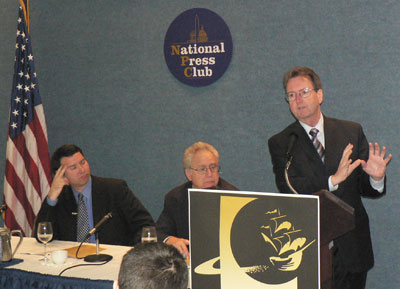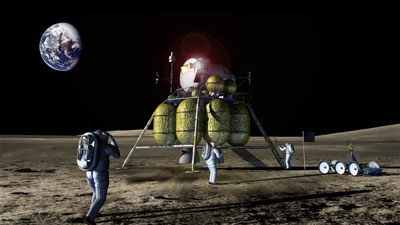New alternatives to the Visionby Jeff Foust
|
| While Obama endorsed the Vision during the campaign, it’s logical to assume that he’ll want to put his own imprint on the agency in general and the exploration effort in particular. |
Last week, the Center for American Progress Action Fund, a progressive think tank, released Change for America, a document it described as a “progressive blueprint” for the next president. (The document is thought to have more influence on the presidential transition than usual since the center’s CEO, John Podesta, is on leave to serve as a co-chair of the Obama transition team.) While the published document contains nothing about space policy, an online addendum featured a number of additional white papers, including one titled “The U.S. Space Program: Restoring Preeminence in Space Science and Exploration” by Neal Lane, science advisor in the Clinton Administration, and George Abbey, former director of NASA’s Johnson Space Center.
The brief white paper (less than four pages) argues that the goals of the Vision do not match the resources allocated to it during the Bush Administration, leading to concerns about an extended gap in US human spaceflight access as well as sharp cuts in other areas of the agency. “NASA is trapped by expectations it cannot meet and promises not kept,” Lane and Abbey write. “Early decisions need to be made by the new president, and those decisions will determine whether the United States continues to lead in space or cede that position to other nations.”
They recommend that the new administration immediately create a commission to examine the status of the space program and make recommendations for short- and long-term actions. Lane and Abbey also call for extending the life of the shuttle “until a suitable replacement becomes available” and for modifying the goals of the Vision “to reflect realistic goals and expectations of future budgets, manpower, national priorities, and opportunities for international cooperation”. They don’t put a price tag on this or other suggestions (including increased support for earth sciences and aeronautics), but extending the shuttle alone would cost at least $2 billion a year, and perhaps up to twice that depending on the level of flight activity. That may be a difficult cost for the new administration to swallow, given that, during the campaign, Obama promised only an additional $2 billion for NASA to narrow the gap between the shuttle and Constellation.
Deferring the Moon
A different alternative to the Vision appeared last week from The Planetary Society. The society released on November 13 “Beyond the Moon: A New Roadmap for Human Space Exploration in the 21st Century”, a document that outlined the direction that the United States, in cooperation with other countries, should take in the exploration of the solar system.
| “NASA is trapped by expectations it cannot meet and promises not kept,” Lane and Abbey write. |
Some elements of The Planetary Society’s roadmap are similar to the current Vision, from its call for retiring the shuttle in 2010 to its long-term goal of human missions to Mars. However, the society’s plan deviates from the Vision in one critical area: it does not support the Vision’s goal of human lunar missions by 2020, stating that those missions should be delayed in favor of human missions beyond the Earth-Moon system, including expeditions to the Earth-Sun L-2 Lagrange point and to near Earth objects.
“Nobody here advocates abandoning the exploration of the Moon or potential human landings on the Moon, absolutely not,” said Jim Bell, a Cornell University planetary scientist and new president of The Planetary Society, at a Washington, DC press conference announcing the report. “However, we believe that those kinds of missions—human missions to the Moon—should be conducted at the right time, when it’s appropriate, and if they can be shown to be critical steps toward the development and validation of this architecture.”
 Scott Hubbard (right) discusses The Planetary Society’s roadmap report as Jim Bell (left) and Lou Friedman look on. (credit: J. Foust) |
Eliminating that 2020 deadline, Louis Friedman, co-founder and executive director of The Planetary Society, both removes obstacles to international participation in the exploration effort and reduces the financial burden on NASA to carry it out. “That date is rather arbitrary, and in many respects prevents international cooperation in a serious way, because the other international players are clearly not ready to be doing human missions to the Moon,” he said.
The document does not indicate just how long of a delay for human lunar landings would result in implementation of this plan. Friedman noted that some have speculated that achieving that 2020 goal under the current approach was unlikely anyway, given the likelihood for schedule delays in the program. “It may be no bigger of a delay than would happen by the realities of future budget cuts,” he said. He did say if he society’s plan develops the way he envisions, the human return to the Moon would be delayed by a few years, “maybe five”.
Building a stronger international partnership for exploration was another cornerstone of the society’s roadmap. NASA is already talking with other countries about participating in lunar exploration, but Friedman said that level of cooperation was not sufficient. That current approach, he argued, locks in at a very early stage what is open to international cooperation and what NASA reserves for itself. “We would say at this point to back off from that, open up the architecture more, and have an international discussion about the contributions of landers and actual vehicles from other countries that will be going to the Moon,” he said. “In that sense it would be different because it would be taking into account human mission aspirations of other countries.”
International cooperation would also play a role in robotic Mars exploration. “After decades of discussion, we think it’s time for an international initiative to uncover the secrets of the Red Planet, and in particular an international robotic Mars sample return,” said Scott Hubbard, former director of NASA’s Ames Research Center and a member of the society’s roadmap study team. Such a mission would not only provide scientists with highly-desired samples of Martian rock and soil for geological and astrobiological research, “it gives you an end-to-end systems-level demonstration of what you need to do to follow on with humans.”
| “Nobody here advocates abandoning the exploration of the Moon or potential human landings on the Moon, absolutely not,” said Bell. “However, we believe that those kinds of missions… should be conducted at the right time, when it’s appropriate.” |
The combination of enhanced international cooperation and deferment of lunar landing elements of the exploration architecture is designed to reduce the financial burden on NASA, particularly in what Friedman called the “middle years” of the exploration plan in the next decade when work on those elements would be ramping up. He declined, though, to give an estimate of the level of funding that NASA needed to carry out this revised approach, other than to support the levels of NASA funding that have been authorized by Congress, which have been up to $2 billion above what has actually been appropriated in recent years. “We don’t really need an increase in the NASA budget, but we probably shouldn’t suffer any more decreases,” he said.
The society did send out mixed messages about key early elements of NASA’s exploration architecture, notably the Ares 1 rocket that will launch the Orion spacecraft. The report endorsed the continued development of Ares and Orion, but Friedman said the study didn’t get too far into the technical details about Ares 1 versus alternative approaches. “There are people who have alternative launch vehicle suggestions; we did not go deep enough into that to choose whether they’re wrong or they’re right,” he said. “That process is going on and probably should be reviewed but we’re not ourselves questioning it.”
Going forward, The Planetary Society plan to take advantage of the presidential transition period, presenting the report to President-Elect Obama’s transition team and also discussing it with members of Congress. Friedman said he hopes that the new Congress will hold hearings on the topic next year. It’s likely that, as others speak up about the future of NASA and its exploration plans, they’ll have plenty of company on Capitol Hill and elsewhere in Washington in the coming weeks and months.
